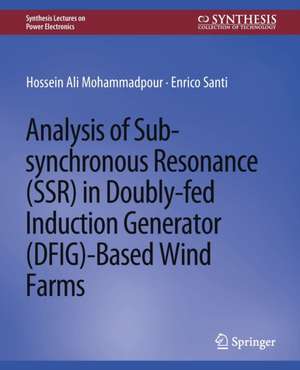Analysis of Sub-synchronous Resonance (SSR) in Doubly-fed Induction Generator (DFIG)-Based Wind Farms: Synthesis Lectures on Power Electronics
Autor Hossein Ali Mohammadpour, Enrico Santien Limba Engleză Paperback – sep 2015
Din seria Synthesis Lectures on Power Electronics
- 15%
 Preț: 523.07 lei
Preț: 523.07 lei -
 Preț: 379.82 lei
Preț: 379.82 lei -
 Preț: 381.29 lei
Preț: 381.29 lei -
 Preț: 191.31 lei
Preț: 191.31 lei -
 Preț: 247.72 lei
Preț: 247.72 lei -
 Preț: 234.87 lei
Preț: 234.87 lei -
 Preț: 234.87 lei
Preț: 234.87 lei -
 Preț: 206.29 lei
Preț: 206.29 lei -
 Preț: 206.84 lei
Preț: 206.84 lei -
 Preț: 488.12 lei
Preț: 488.12 lei -
 Preț: 447.24 lei
Preț: 447.24 lei -
 Preț: 455.71 lei
Preț: 455.71 lei -
 Preț: 259.41 lei
Preț: 259.41 lei -
 Preț: 359.88 lei
Preț: 359.88 lei -
 Preț: 372.11 lei
Preț: 372.11 lei
Preț: 158.28 lei
Nou
Puncte Express: 237
Preț estimativ în valută:
30.29€ • 31.51$ • 25.01£
30.29€ • 31.51$ • 25.01£
Carte tipărită la comandă
Livrare economică 14-28 aprilie
Preluare comenzi: 021 569.72.76
Specificații
ISBN-13: 9783031013737
ISBN-10: 3031013735
Ilustrații: VIII, 55 p.
Dimensiuni: 191 x 235 mm
Greutate: 0.13 kg
Editura: Springer International Publishing
Colecția Springer
Seria Synthesis Lectures on Power Electronics
Locul publicării:Cham, Switzerland
ISBN-10: 3031013735
Ilustrații: VIII, 55 p.
Dimensiuni: 191 x 235 mm
Greutate: 0.13 kg
Editura: Springer International Publishing
Colecția Springer
Seria Synthesis Lectures on Power Electronics
Locul publicării:Cham, Switzerland
Cuprins
Introduction.- Modeling of DFIG-Based Wind Farm for SSR Analysis.- Induction Generator Effect.- Torsional Interactions.- Control Interactions.- Bibliography.- Authors' Biographies .
Notă biografică
Hossein Ali Mohammadpour (IEEE S '2009 - M '2015) received the B.Sc. and M.Sc. degrees all in electrical engineering power systems from the Iran University of Science and Technology (IUST), Tehran, Iran, in 2006 and 2009, respectively. He also received the Ph.D. degree in electrical engineering with focus on renewable energy systems from the University of South Carolina, Columbia, SC, USA, in December 2014, where he continued as a postdoctoral fellow until March 2015. Since March 2015, he has been with the NRG Renew, Scottsdale AZ, USA as a Senior Power Systems Engineer. Dr. Mohammadpour has published over fifty papers in power systems, power electronics, and renewable energy resources in international journals and conference proceedings. His current research interests include power systems stability and control, micro-grid systems, photovoltaic, battery energy storage systems, and smart grid. Enrico Santi received the Dr. Ing. degree in electrical engineering from the University of Padua, Italy in 1988 and the M.S. and Ph.D. degrees from Caltech in 1989 and 1994, respectively. He worked as a senior design engineer at TESLAco from 1993 to 1998, where he was responsible for the development of various switching power supplies for commercial applications. Since 1998 he has been with the University of South Carolina where he is currently an associate professor in the electrical engineering department. Dr. Santi has published over one hundred and fifty papers in power electronics and modeling and simulation in international journals and conference proceedings, is co-author of two books and holds three patents. His research interests include switched-mode power converters, advanced modeling and simulation of power systems, modeling and simulation of semiconductor power devices, control of power electronics systems
